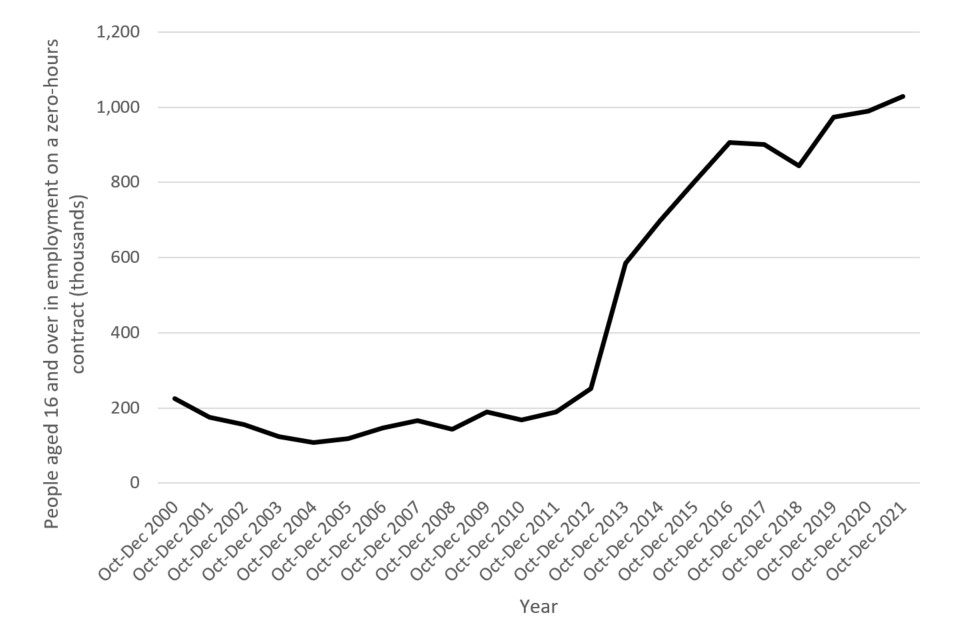Precarious work is on the rise: Why is this a problem?
Posted on: 8 March 2022 by James Hickson in Blog

In the first of two blogs, Heseltine Institute Research Associate James Hickson explores the scale of precarious work in the contemporary UK labour market, and outlines why this poses a distinct threat to individuals, communities, and local economies.
Introduction
The recent labour market overview from the Office for National Statistics paints a broadly positive picture of the UK’s early post-pandemic recovery. Following nearly two years of economic disruption - unparalleled in living memory - employment is again rising, unemployment is falling, and the number of payrolled employees is at a record 29.5 million.
The Government are, predictably, keen to take credit for this seeming jobs miracle, with the Prime Minister claiming at PMQs in February “our plan for jobs is working”, and emphasising the UK’s record low youth unemployment as a particular success.
However, as we assess the strength of the UK’s economic recovery, as well as the prospects for longer-term shared prosperity, it’s important to focus on the quality and not just the quantity of employment in the labour market. People may be in work, but for too many in the UK, the latest evidence confirms, this work is increasingly precarious.
Precarious work in the UK labour market
“Precarious work” describes any form of employment where one’s access to work is uncertain and one’s income unpredictable. Paradigmatic examples of this in the contemporary UK labour market can be found in zero-hours contract employment, as well as the so-called “gig economy” work associated with online platforms such as Uber and Deliveroo. For workers, such employment practices provide no guaranteed minimum of paid work or stable source of income. Work can instead be demanded, denied, or discontinued completely at short notice, and with ease, by employers. Precarious work is also often concentrated in low-wage sectors of the economy and is associated with limited access to labour rights and protections, intensifying the insecurity faced by many workers still further.
The distinct combination of jeopardy, uncertainty, and dependence faced by these workers contrasts starkly with the model of long-term, full-time, stable employment that had previously become the established norm for many in the UK during the middle of the twentieth century. As a result of their employment conditions, many precarious workers in today’s labour market are left perpetually on the precipice of severe poverty, with little capacity to meaningfully plan their finances, their lives, or their futures.
The pandemic has seen a steady entrenchment of precarious working arrangements in the UK. Recent research published by the TUC shows that 4.4 million working adults in England and Wales (14.7%) now use a gig economy platform to access work at least once a week, a figure that has almost tripled in the last five years.
Indeed, gig economy work has become even more ubiquitous during the pandemic, with delivery riders for platforms such as Deliveroo and Uber Eats now increasingly visible in towns and cities across the UK. The rapid growth of such companies, and their capture of the markets and distribution networks for local goods and services, has been aided, in particular, by periods of mandated social distancing during which people have been less able to visit traditional bricks-and-mortar shops and restaurants. For example, Deliveroo saw its year on year global sales double in the first quarter of 2021, due in no small part to the widespread introduction of lockdowns to curb the spread of COVID-19.
Zero-hours contracts, too, are on the rise again. The latest data from the Office for National Statistics suggests that more than 1 million adults of working age in the UK (3.2%) were employed on a zero-hours contract in the last quarter of 2021, compared to just 190,000 a decade ago (see Figure 1). Younger workers appear to be disproportionately impacted: 11.3% of people aged 16-24 in the UK were employed on a zero-hours contract in the last quarter of 2021, compared to just 1.7% of people aged 35-49. This echoes recent research by the Resolution Foundation, which found that younger people who have recently returned to work “post-lockdown” are more likely than average to be on insecure contracts. Record low youth unemployment, it seems, rests on a growing foundation of precarious work.

Figure 1: People aged 16 and over in employment on a zero-hours contract (thousands), Q4 annually 2000-2021. (Source: ONS Labour Force Survey).
The continued rise of precarious working arrangements in the UK reflects a longer-term international trend – a “great risk shift” – that has accelerated in the years following the 2007/08 financial crisis as employers have sought to navigate economic uncertainty by adopting more insecure temporary or part-time employment practices. In a context of further economic volatility in the wake of Brexit, the COVID-19 pandemic, rapid technological disruption, geopolitical instability, and climate change there is no reason to think that employers will not continue to place the burden of this uncertainty disproportionately on workers, favouring market dynamism and labour flexibility over providing a secure livelihood to their staff.
What’s wrong with precarious work?
Some may argue that precarious working arrangements are not only useful in a context of economic uncertainty, but in fact necessary to provide flexibility in the face of fluctuating market demand. Others may argue that any employment, no matter how precarious the conditions, is preferable to unemployment and reliance on the welfare state. And others still may argue that precarious working arrangements are superior to more stable modes of employment, as they offer individuals greater freedom and flexibility over when and where they work. Indeed, there is evidence that many workers themselves highlight “independence and flexibility” as a benefit of working in the gig economy. However, I argue that such defences underestimate, or ignore, the regressive political, economic, and social implications of precarious working arrangements, as well as the particular threat they pose to long-term economic recovery and resilience.
As I have previously argued elsewhere (here and here) precarious working arrangements are politically significant to the extent that they undermine freedom. As a result of their insecure employment, precarious workers are dominated – vulnerable to the extraordinary discretionary power of employers who have the capacity to demand, deny, or discontinue work at will and with impunity. This power, exercised or unexercised, compromises workers’ ability to meaningfully plan their own lives and make ends meet. To the extent that workers happen to escape severe interference – if they are able to maintain something like stable working patterns and income streams – they do so entirely at the discretion of their employer, who remains free to intervene at any time. Individual workers have few, if any, means to resist or repel this interference, and instead must be always on call and on standby for the next shift and the next job. Far from offering an attractive vision of flexibility and independence in the labour market, precarious work instead offers only extreme subjection to the arbitrary power of employers and the influence they wield over lives and livelihoods.
Precarious work is neither liberating, nor is it economically necessary. This has long been understood. Eleanor Rathbone’s 1904 report into casual labour at Liverpool docks highlighted then that the “need” for flexible ad-hoc employment can often be as much to do with market inefficiency (e.g. too many employers competing in a limited market) as actual fluctuations in demand. Denying working people a secure livelihood is an economic choice, not an inevitability.
But as well as being unnecessary, an overabundance of precarious work can also be deeply detrimental to a local economy. Evidence suggests that there is a strong correlation between poor employment conditions and poor productivity, as well as low levels of innovation. Meanwhile, a paucity of well-paying, secure jobs helps to perpetuate cycles of deprivation – limiting local consumer spending power, starving communities of sufficient investment, and driving down quality of life. In particular, precarious work can be seen to risk intensifying a number of systemic economic challenges such as housing insecurity, problem debt, and child poverty that must be addressed in order to deliver meaningful shared prosperity. Rathbone recognised this point too, highlighting how low wages and irregular work often left nineteenth century Liverpool dockers and their families “near the margin of destitution”, even as the economy boomed. In the present context of an accelerating cost of living crisis, maintaining the system of precarious work, and allowing its normalisation across a local labour market, acts as a chokehold on efforts to rebuild community wealth, promote post-pandemic recovery, and close regional prosperity gaps.
Finally, precarious work is not only economically harmful, it is socially harmful too. Public Health England research shows that insufficient income is associated with worse outcomes across virtually all domains, including long-term health and life expectancy, and that living on a low income is associated with a greater risk of limiting illness and poor mental health. Insecurity of work has also been associated with a range of psychological and physical health impacts, with evidence that zero-hours contracts in particular are associated with levels of stress that are harmful to health. Indeed, in one study, researchers found that people on zero-hours contracts were less likely to report feeling healthy compared to those in more secure employment, and were at greater risk of reporting symptoms of psychological distress. In this respect, poor quality employment practices are comparable to pollution: an avoidable and unnecessary by-product of a certain approach to economic production, that is harmful to public health and creates added pressure on healthcare systems. A new economic model is needed to clean up our labour market.
Conclusion
There should be no complacency over the continued rise of precarious employment in the UK labour market. With many communities already facing an uphill battle to rebuild their local economies in the wake of deindustrialisation, the financial crisis, austerity, and Brexit – and with recovery from the pandemic still fragile – the normalisation of zero hours contracts, gig work, and other forms of precarious work must now be resisted. Such work undermines the delivery of meaningful shared prosperity, eroding the health, wealth, and wellbeing of people and their communities. More fundamentally, it also undermines the value of individual liberty, a value that is routinely co-opted to defend the insecure models of employment that put it at risk. Novel strategies to eliminate precarious work from the labour market are therefore needed if places are to truly ‘build back better’ from the pandemic and deliver a fair, free, and inclusive economy for all.
What can be done about precarious work? In part two of this blog series, I will argue that local solutions to the problem of precarious work are now increasingly necessary, and outline the ways that communities can (and already are!) fighting back.
Keywords: .